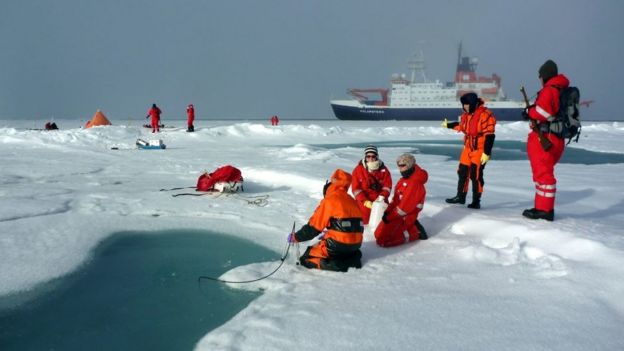Record concentration of microplastics found in Arctic

Record levels of microplastics have been found trapped inside sea ice floating in the Arctic.
Ice cores gathered across the Arctic Ocean reveal microplastics at concentrations two to three times higher than previously recorded.
As sea ice melts with climate change, the plastic will be released back into the water, with unknown effects on wildlife, say German scientists.
Traces of 17 different types of plastic were found in frozen seawater.
Microplastics are tiny plastic pieces under five millimetres long. They can be eaten by filter-feeding animals and passed up the food chain.
A considerable amount of microplastic is released directly into the ocean by the gradual breakdown of larger pieces of plastic. But microplastics can also enter the sea from health and beauty products, washing synthetic textiles or abrasion of car tyres.
Their "plastic fingerprint" suggests they were carried on ocean currents from the huge garbage patch in the Pacific Ocean or arose locally due to pollution from shipping and fishing.
If you have a question about plastics, you can email haveyoursay@bbc.co.uk
More than half of the microplastic particles within the ice were so small that they could easily be ingested by sea life, said Ilka Peeken of the Alfred Wegener Institute, Helmholtz Centre for Polar and Marine Research in Bremerhaven, Germany, who led the study.
"No one can say for certain how harmful these tiny plastic particles are for marine life, or ultimately also for human beings," she said.
Smaller than human hair
The ice cores were gathered from five regions throughout the Arctic Ocean in the spring of 2014 and summer of 2015. They were taken back to the laboratory, where they were analysed for their unique plastic "fingerprint".
"Using this approach, we also discovered plastic particles that were only 11 micrometres across," said co-researcher Gunnar Gerdts, also from the Alfred Wegener Institute.
"That's roughly one-sixth the diameter of a human hair, and also explains why we found concentrations of over 12,000 particles per litre of sea ice - which is two to three times higher than what we'd found in past measurements."

The researchers found a total of 17 different types of plastic in the sea ice, including packaging materials like polyethylene and polypropylene, but also paints, nylon, polyester, and cellulose acetate (used to make cigarette filters).
They say the plastic found its way to the Arctic Ocean from the huge garbage patch in the Pacific Ocean or from ship's paint and fishing nets.
"These findings suggest that both the expanding shipping and fishing activities in the Arctic are leaving their mark," said Dr Peeken.
"The high microplastic concentrations in the sea ice can thus not only be attributed to sources outside the Arctic Ocean. Instead, they also point to local pollution in the Arctic."
Melting sea ice
The study confirms that sea ice traps large amounts of microplastics and transports them across the Arctic Ocean. The plastic particles will be released back into the ocean when the sea ice melts.
"As climate change will accelerate sea ice melting, more microplastics will be released from the sea ice and will enter the marine environment," said Dr Pennie Lindeque, lead plastics scientist at Plymouth Marine Laboratory, who was not part of the research team.

Dr Jeremy Wilkinson, a sea ice physicist at the British Antarctic Survey, said the work, published in Nature Communications, was a "benchmark study".
"Microplastic particles were found throughout all cores sampled," he said. "It suggests that microplastics are now ubiquitous within the surface waters of the world's ocean. Nowhere is immune."
And Dr Jason Holt of the National Oceanography Centre said we might expect plastic waste from some European countries to eventually end up in the Arctic, due to ocean circulation patterns.
"It is therefore vital to understand the transport and fate of plastic waste in the Arctic and how it impacts on the marine environment there, and what can be done to reduce this impact," he said.
Estimates suggest about eight million tonnes of plastic move from the land into the ocean every year, with some finding its way into remote areas, such as the Polar Regions and the deep ocean floor.
Source: http://www.bbc.com/news/science-environment-43879389


No comments